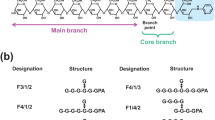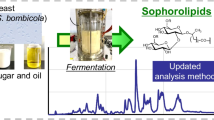Summary
Iron(III) hydroxide oxide [Fe(OH)O] efficiently catalyzed the condensation of 25 MM dl-glyceraldehyde to ketohexoses at 25°C (pH 5–6). At 16 days the yields were sorbose (15.2%), fructose (12.9%), psicose (6.1%), tagatose (5.6%), and dendroketose (2.5%) with 19.6% of triose unreacted. Analysis at 96 days showed no decomposition of hexoses. Under these conditions Fe(OH)O also catalyzed the isomerization and rearrangement of glyceraldehyde to dihydroxyacetone and lactic acid, respectively. In these reactions, about 10% of the glyceraldehyde was oxidized to glyceric acid with concurrent reduction of the iron(III) to iron(II). The partial reduction of Fe(OH)O did not noticeably reduce its ability to catalyze hexose synthesis. The relationship of these results to prebiotic sugar synthesis is discussed.
Similar content being viewed by others
References
Beck WS (1957) Assay of triose phosphates. In: Colowick SP, Kaplan NO (eds) Methods in enzymology, vol III. Academic Press, New York, p 201
Cairns-Smith AG (1978) Precambrian solution photochemistry, inverse segregation, and banded iron formation. Nature (Lond) 276:807–808
El Khadem HS, Ennifar S, Isbell HS (1987) Contribution of the reaction pathways involved in the isomerization of monosaccharides by alkali. Carbohydr Res 169:13–21
Feather MS, Harris JF (1973) Dehydration reactions of carbohydrates. In: Tipson RS, Horton D (eds) Advances in carbohydrate chemistry and biochemistry, vol 28. Academic Press, New York, p 161
Fedoronko M, Konigstein J (1969) Kinetics of mutual isomcrization of trioses and their dehydration to methylglyoxal. Collect Czech Chem Commun 34:3881–3894
Gabel NW, Ponnamperuma C (1967) Model for origin of monosaccharides. Nature (London) 216:453–455
Geissman TA (1960) The Cannizzaro reaction. In: Adams R (ed) Organic reactions, vol II. John Wiley and Sons, New York, p 94
Getoff N, Scholes G, Weiss J (1960) Reduction of carbon dioxide in aqueous solutions under the influence of radiation. Tetrahedron Lett 17–23
Gutsche CD, Redmore D, Buriks RS, Nowotny K, Grassner H, Armbruster CW (1967) Base-catalyzed triose condensations. J Am Chem Soc 89:1235–1245
Harsch G, Harsch M, Bauer H, Voelter W (1983) Produktverteilung und mechanismus der gesamtreaktion der formose-reaktion. Z Naturforsch Teil B 38:1269–1280
Harsch G, Bauer H, Voelter W (1984) Kinetik, katalyse and mechanismus der sekundarreaktion in der schlussphase der formose-reaktion. Justus Liebigs Ann Chem 623–635
Harvey GR, Mopper K, Degens ET (1972) Synthesis of carbohydrates and lipids on kaolinite. Chem Geol 9:79–87
Jencks WP (1969a) Catalysis in chemistry and enzymology, chapter 2. McGraw-Hill, New York, p 120
Jencks WP (1969b) Catalysis in chemistry and enzymology, chapter 2. McGraw-Hill, New York, p 154
Komadel P, Stucki JW (1988) Quantitative assay of minerals for Fe+ and Fe3+ using 1,10-phenanthroline: III. A rapid photochemical method. Clay Clay M 36:379–381
Lederer E, Lederer M (1957) Chromatography. Elsevier, New York, p 184
Miller SL (1957) The formation of organic compounds on the primitive earth. Ann NY Acad Sci 69:260–275
Mizuno T, Weiss AH (1974) Synthesis and utilization of formose sugars. In: Tipson RS, Horton D (eds) AAdvances in carbohydrate chemistry and biochemistry, vol 29. Academic Press, New York, p 173
Morgenlie S (1988) Changes in stereoselectivity in the triose aldol condensation with increased concentration of alkaline-earth metal ions. Acta Chem Scand B 42:546–549
Perlin AS (1962) Trioses: D-, L-, and DL-glyceraldehyde, oxidative degradation of ketohexoses. In: Whistler RL, Wolfrom ML (eds) Methods in carbohydrate chemistry, vol 1. Academic Press, New York, p 61
Pigman W, Anet EFLJ (1972) Mutarotations and actions of acids and bases. In: Pigman W, Horton D (eds) The carbohydrates, vol 1A. Academic Press, New York, p 165
Pinto JP, Gladstone GR, Yung YL (1980) Photochemical production of formaldehyde in Earth's primitive atmosphere. Science 210:183–185
Putnam EW (1957) Paper chromatography of sugars. In: Colowick SP, Kaplan NO (eds) Methods in enzymology, vol III. Academic Press, New York, p 62
Reid C, Orgel LE (1967) Synthesis of sugars in potentially prebiotic conditions. Nature (Lond) 216:455
Socha RF, Weiss AH (1981) Homogenously catalyzed condensation of formaldehyde to carbohydrates. J Catal 67:207–217
Speck JC (1958) The Lobry de Bruyn-Alberda van Ekenstein transformation. In: Wolfrom ML (ed) Advances in carbohydrate chemistry, vol 13. Academic Press, New York, p 63
Stucki JW (1981) The quantitative assay of minerals for Fe2+ and Fe3+ using 1,10-phenanthroline: II. A photochemical method. Soil Sci Soc Am J 45:638–641
Stucki JW, Anderson WL (1981) The quantitative assay of minerals for Fe2+ and Fe3+ using 1,10-phenanthroline: I. Sources of variability. Soil Sci Soc Am J 45:633–637
Swain CG, Powell AL, Sheppard WA, Morgan CR (1979) Mechanism of the Cannizzaro reaction. J Am Chem Soc 101:3576–3587
Thauer RK, Jungermann K, Decker K (1977) Energy conservation in chemotrophic anaerobic bacteria. Bacteriol Rev 41:100–180
Waldi D (1965) Spray reagents for thin-layer chromatography. In: Stahl E (ed) Thin-layer chromatography. Academic Press, New York, p 483
Weber AL (1983) Thiol-catalyzed formation of lactate and glycerate from glyceraldehyde. J Mol Evol 19:237–243
Weber AL (1987a) Oligoglyceric acid synthesis by autocondensation of glycerol thioester. J Mol Evol 25:191–196
Weber AL (1987b) The triose model: glyceraldehyde as a source of energy and monomers for prebiotic condensation reactions. Origins Life 17:107–119
Weber AL (1991) Origin of fatty acid synthesis: thermodynamics and kinetics of reaction pathways. J Mol Evol 32:93–100
Author information
Authors and Affiliations
Rights and permissions
About this article
Cite this article
Weber, A.L. Prebiotic sugar synthesis: Hexose and hydroxy acid synthesis from glyceraldehyde catalyzed by iron(III) hydroxide oxide. J Mol Evol 35, 1–6 (1992). https://doi.org/10.1007/BF00160255
Received:
Accepted:
Issue Date:
DOI: https://doi.org/10.1007/BF00160255




